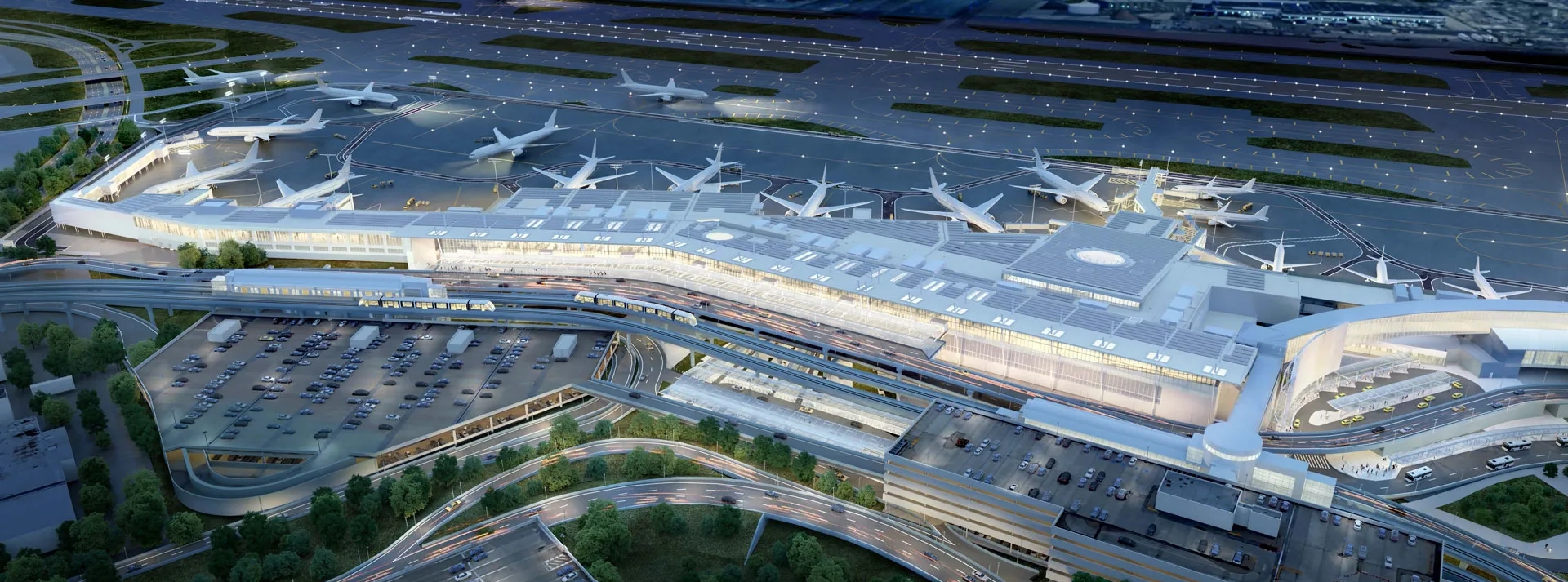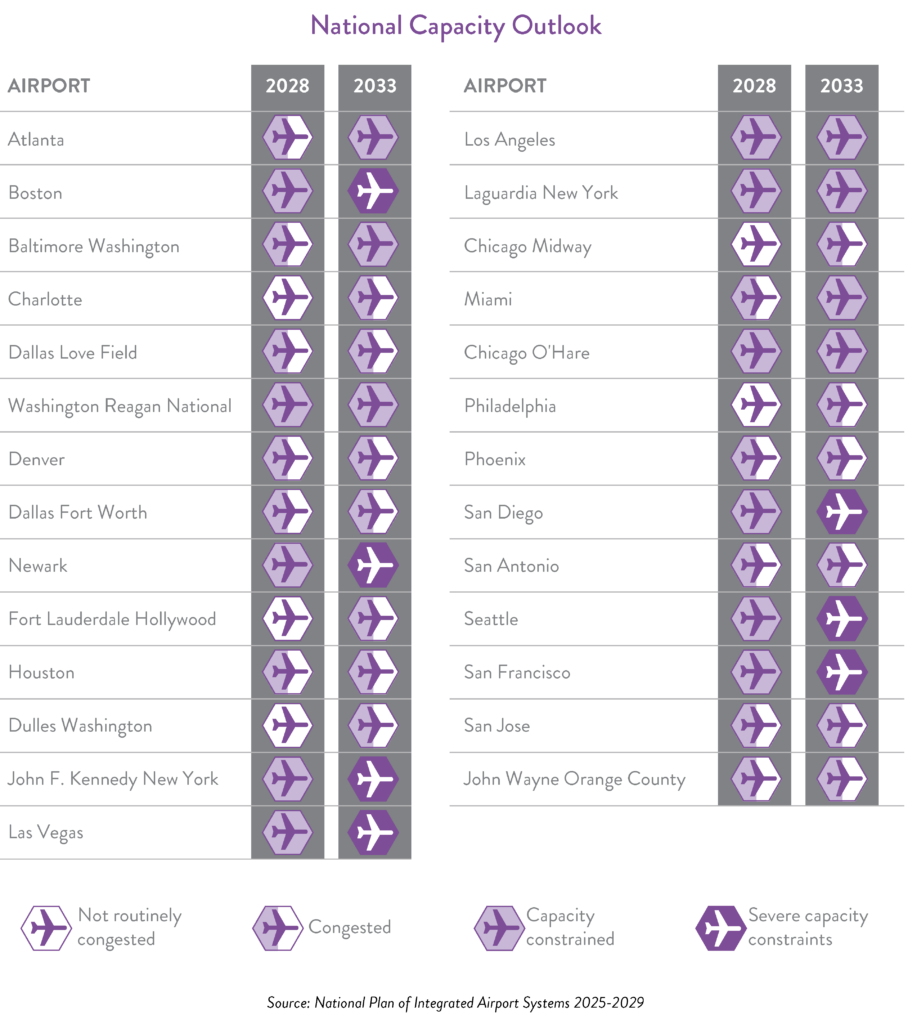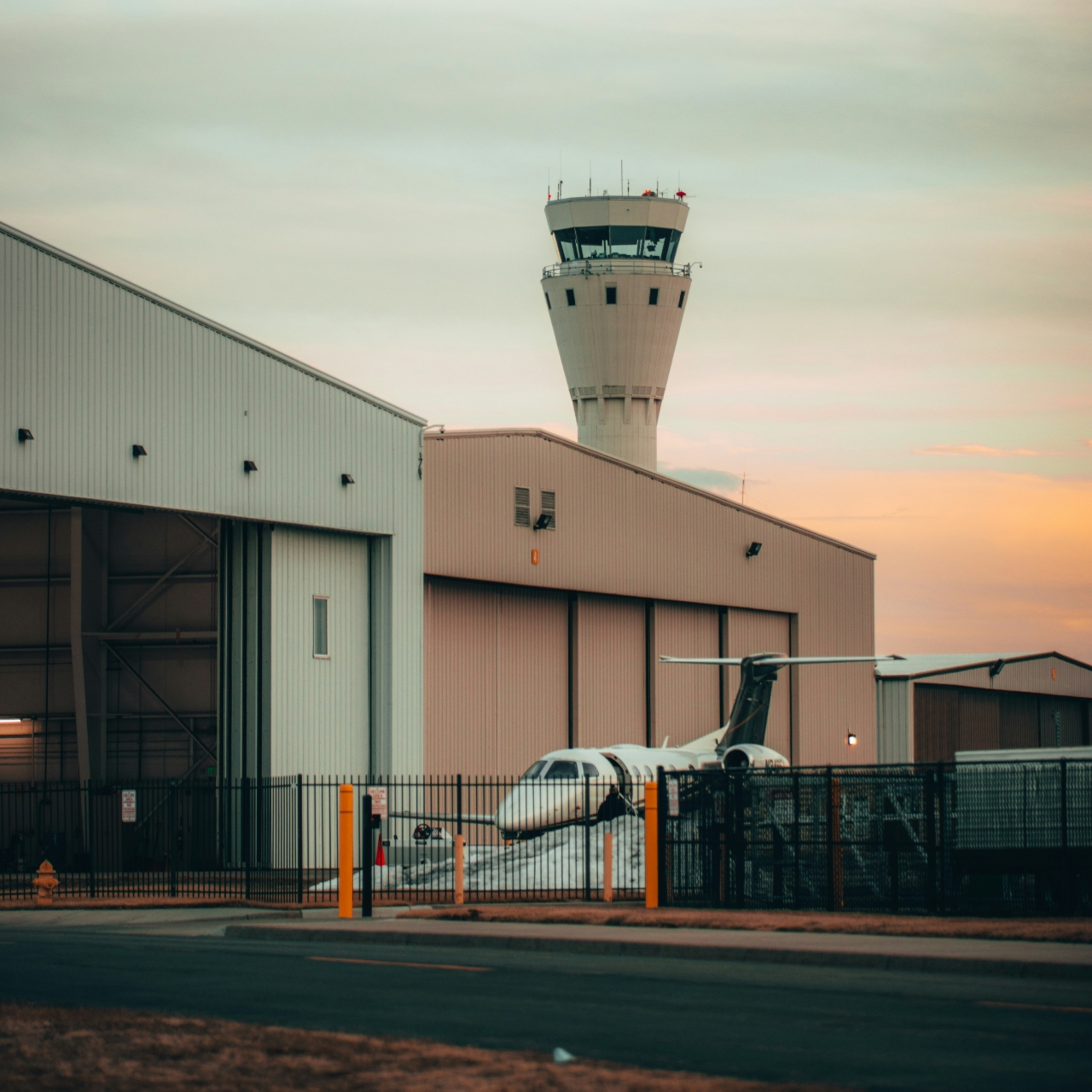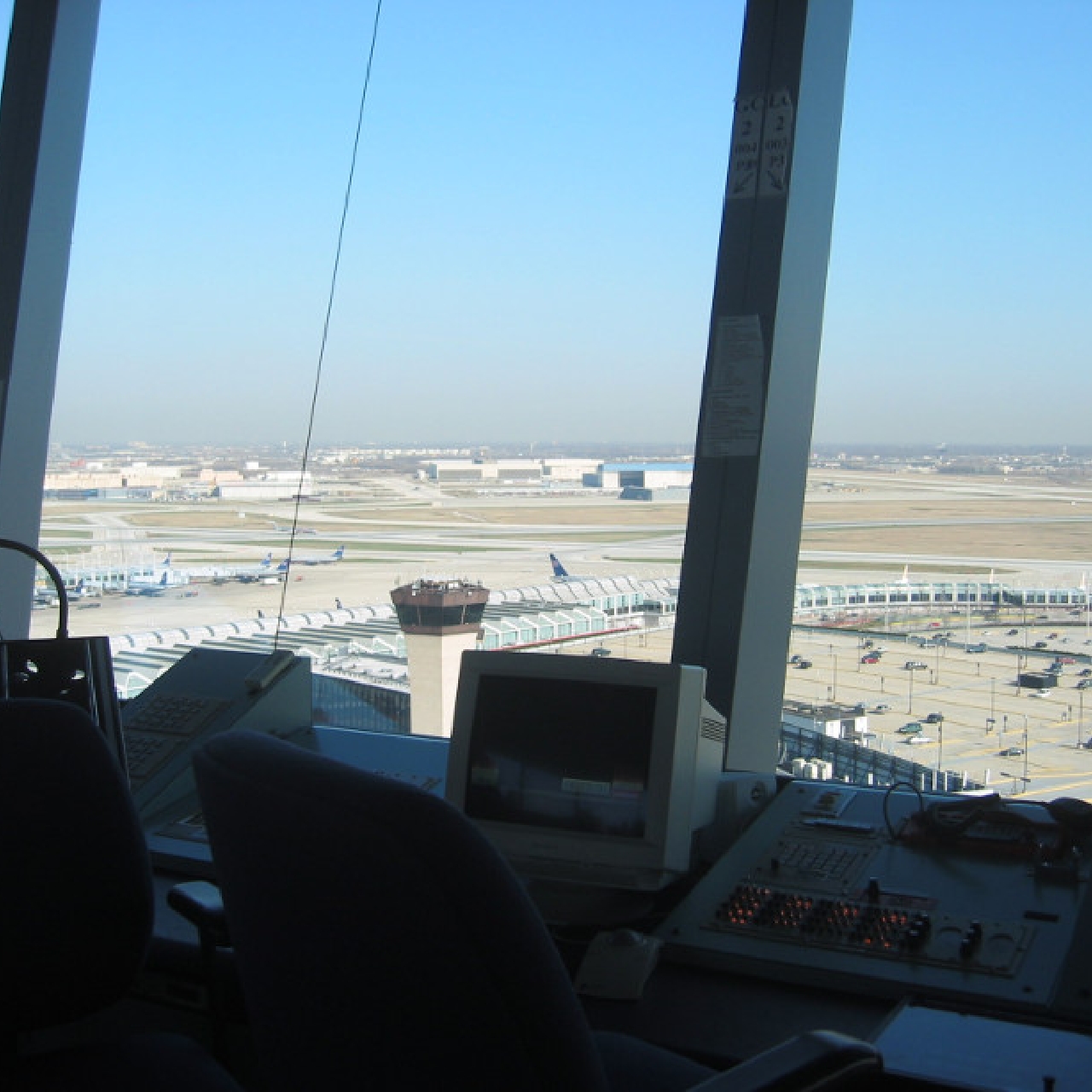Georgia, Inland Waterways, National Category
Startup Uses Drone for Cleaning Water, Collecting Data


U.S. domestic air passenger enplanements increased steadily throughout the last decade, from 629.5 million in 2010 to 811.4 million in 2019. Following the COVID-19 pandemic, air travel has fully recovered to 819.5 million in 2023 and continues to increase. Passenger traffic is forecasted to grow 58% to 1.28 billion annual passengers by 2040. The pandemic did not impact air cargo, and 2021 saw the most cargo in history, with 125.3 million metric tons carried. Funding from the 2021 Infrastructure Investment and Jobs Act (IIJA), which provided $25 billion over five years, and local investments are enhancing passenger experience, especially at larger airports. Still, delays continue to be a major problem because of ongoing workforce and modernization challenges. Although modest funding increases in the latest Federal Aviation Administration (FAA) reauthorization is a positive step, the continued failure to raise the cap on the Passenger Facility Charge represents a missed opportunity, because the projected funding gap is $114 billion over the next 10 years and additional resources will be needed to address this deficit.
Airport infrastructure extends well beyond the runways and terminals that are familiar to passengers. Airport facilities include runways, taxiways, control towers, firefighting and rescue services, passenger terminals, cargo facilities, general aviation facilities, parking garages, access road networks, public transport, lighting, navigational and approach aids, and various support facilities.
There are 13,144 airports nationwide, but the backbone of the nation’s aviation system is the 3,247 that are part of the National Plan of Integrated Airport Systems (NPIAS) as defined by the Federal Aviation Administration (FAA). NPIAS airports include all commercial service airports; all reliever airports, which are built to relieve temporary congestion at commercial service airports; and selected public-owned general aviation airports. Approximately 97% (3,193) of the NPIAS airports are owned by public entities (generally, city, county, or state governments) and less than 2% (54) are privately owned airports.
Because of investments from the IIJA, several high- profile airport construction projects are underway. These include projects to modernize terminals, improve security screen areas, add new parking facilities, improve airport roadways, consolidate rental car facilities, and more. Among the airports undergoing transformation are some of the most traveled nationwide, such as New York’s LaGuardia and Kennedy, Los Angeles, Dallas-Fort Worth, Chicago O’Hare, Kansas City, and Seattle-Tacoma.

that air passenger traffic will increase from 811 million passengers in 2023 to
1.3 billion passengers by 2044
face a workforce gap of
3,000 air traffic controllers
that nearly $68 billion is needed between 2025 and 2029 for
capital development projects

In 2019, the U.S. aviation industry contributed 4.9% to the U.S. Gross Domestic Product (GDP) and generated $1.9 trillion in total economic activity, supporting 10 million American workers. At the state level, impacts vary by population, number of airports, aviation manufacturing, tourism, and other aviation-related business activities. In 2020, the pandemic resulted in a significant decrease in the number of passengers at U.S. airports, while overall economic activity and jobs supported saw similar declines, averaging 50% of the previous year’s numbers.
In 2019, the U.S. aviation industry contributed 4.9% to the U.S. Gross Domestic Product (GDP) and generated $1.9 trillion in total economic activity, supporting 10 million American workers. At the state level, impacts vary by population, number of airports, aviation manufacturing, tourism, and other aviation-related business activities. In 2020, the pandemic resulted in a significant decrease in the number of passengers at U.S. airports, while overall economic activity and jobs supported saw similar declines, averaging 50% of the previous year’s numbers.
U.S. airspace recorded 15.7 million flights in 2023. Domestic U.S. passenger enplanement levels increased steadily throughout 2010, from 629.5 million in 2010 to 811.4 million in 2019. This is followed by the COVID- impacted years with 337.4 million passengers in 2020, 605.9 million in 2021, and fully rebounding back to 819.5 million in 2023. The number of enplanements differs from the number of passengers because passengers may board more than one flight between their origination point and ultimate destination. The FAA projects that passenger traffic will increase at a rate of 2.5% annually between 2023 and 2044 or from 811 million to 1.3 billion. Both existing and new passenger traffic require airports to juggle the responsibilities of maintaining and modernizing legacy assets while also adding new capacity.
The pandemic drove a temporary increase in air cargo operations, and 2021 experienced the most cargo in history, with 125.3 million metric tons carried compared to 120.1 million tons in 2019. For 2022, the amount dropped to 115.9 million metric tons, mostly attributed to the cooling down of the market after a robust growth phase during the pandemic. U.S. air carriers flew 7.3 billion revenue ton miles (RTMs) in 2023 and are expected to increase at an average annual rate of 3%.
[site_chart id="19204"]The FAA conducted a national capacity evaluation in 2024 and found that 11 airports are expected to be runway capacity–constrained by 2028, increasing to 14 by 2033. An additional 13 airports are at risk of significant congestion through 2033. Airports that exceed 80% of their hourly runway capacity for at least 50% of the time are considered capacity-constrained. Although aircraft operations can continue to grow at capacity- constrained airports, growth will result in increasing levels of congestion and reduced levels of efficiency.

Another visible measure of aviation capacity is flight delays, which create passenger frustration and have economic costs. Delays are caused by various factors, including late aircraft arrivals, national aviation system delays, air carrier delays, weather-related issues, and airline IT issues. In 2019, 21.7% of flights failed to arrive on time. That percentage increased to 23.2% in 2023.
[site_chart id="19203"]While the FAA has made progress modernizing air traffic management, known as the Next Generation Air Transportation System (NextGen), progress continues to be slowed down by issues ranging from delays in upgrades, removal of outdated equipment, lack of senior staff who are familiar with the older equipment, as well as a lack of materials to repair older equipment. The FAA spent at least $14 billion on NextGen between 2007 and 2022; however, in 2018, costs were expected to more than double to at least $35 billion by 2030. According to the Government Accountability Office (GAO), the FAA needs to provide greater transparency on costs, schedule, and performance goals for NextGen to enhance accountability of the program.
Commercial airports are traditionally supported by four sources of funding: airport-generated revenue; general obligation bonds; federal, state, and local grants, which include the Airport Improvement Program (AIP); and Passenger Facility Charges (PFCs). The IIJA provided $25 billion in additional aviation infrastructure investments. This includes $5 billion for air traffic facilities, $15 billion for airport infrastructure to increase safety and expand capacity, and $5 billion for airport terminals, on-airport rail, and airport-owned towers.
Commercial airports are traditionally supported by four sources of funding: airport-generated revenue; general obligation bonds; federal, state, and local grants, which include the Airport Improvement Program (AIP); and Passenger Facility Charges (PFCs). The IIJA provided $25 billion in additional aviation infrastructure investments. This includes $5 billion for air traffic facilities, $15 billion for airport infrastructure to increase safety and expand capacity, and $5 billion for airport terminals, on-airport rail, and airport-owned towers.
 In 2024, the most recent FAA reauthorization was signed into law, which allocated $105.5 billion for FAA programs through Fiscal Year 2028. The legislation increases AIP funding to $4 billion per year beginning in FY25, a bump from the $3.35 billion per year that had been in place since FY12. AIP provides grants to airports for projects such as airfield and airport access improvements and capacity enhancements. Funding for AIP grants flows from the Airport & Airway Trust Fund (AATF), which receives revenues from various excise taxes imposed on users of the airport system, including the ticket tax of 7.5% on all domestic travel and a flight segment tax of $5.20 in 2025, $22.20 for international segments, and $11.10 for Alaska and Hawaii. However, as airlines have implemented à la carte pricing, ticket price revenue has suffered because the 7.5% tax is not applied to baggage fees, food sales, or other discretionary passenger purchases. If $4.9 billion in baggage fees collected by airlines in 2018 had been subject to the tax, excise tax revenues would have been about $367 million higher that year alone.
In 2024, the most recent FAA reauthorization was signed into law, which allocated $105.5 billion for FAA programs through Fiscal Year 2028. The legislation increases AIP funding to $4 billion per year beginning in FY25, a bump from the $3.35 billion per year that had been in place since FY12. AIP provides grants to airports for projects such as airfield and airport access improvements and capacity enhancements. Funding for AIP grants flows from the Airport & Airway Trust Fund (AATF), which receives revenues from various excise taxes imposed on users of the airport system, including the ticket tax of 7.5% on all domestic travel and a flight segment tax of $5.20 in 2025, $22.20 for international segments, and $11.10 for Alaska and Hawaii. However, as airlines have implemented à la carte pricing, ticket price revenue has suffered because the 7.5% tax is not applied to baggage fees, food sales, or other discretionary passenger purchases. If $4.9 billion in baggage fees collected by airlines in 2018 had been subject to the tax, excise tax revenues would have been about $367 million higher that year alone.
The other primary source of federal airport funding is the PFC for airport improvements. The PFC’s federally mandated cap of $4.50 has been in place since 2001. Increasing the PFC has long been a recommendation of airport supporters, because it permits local airports to set rates and provides funding flexibility. In 2020, airports collected $2.1 billion in PFCs, down from $3.7 billion in 2018. The flat PFC rate has been in place for nearly 25 years and hinders airports’ ability to collect sufficient revenue necessary for repairs. The FAA Reauthorization Act of 2024 failed to increase the PFC cap, but the legislation allows airports that charge the maximum $4.50 fee to keep a larger percentage of their primary entitlements. Previously, airports had to turn back 75% of their AIP apportionment funding, but under the legislation, those airports charging the maximum fee only need to turn back 60%.
Airports reported grant receipts totaling $5.5 billion in 2020 (up from $2.2 billion in 2018). Federal relief legislation steadied what could have been COVID’s catastrophic, long-term impact. In 2020 and 2021, federal COVID relief packages provided $20 billion for U.S. airports experiencing a severe downturn in operating revenues. However, most airports used federal relief dollars to offset operating costs and debt service rather than for new capital investment. Beyond federal funding, airports issued $13.3 billion in bonds in 2020.
Innovation in airport project delivery methods have added flexibility to airports’ ability to finance and construct new facilities. The construction manager at risk (CMAR) delivery method continues to grow in popularity with large, complex airport projects, because the collaborative approach provides potential for schedule and cost- certainty. The CMAR is a single party that acts as both the construction manager and general contractor, responsible for overseeing the project, managing costs, and ensuring the project is completed on time and within budget.
FAA’s Airport Investment Partnership Program permits the sale or lease of public airports to private entities, but few airports have participated. Public–private partnerships (P3s), on the other hand, are common, especially in the Northeast. After a successful P3 project at LaGuardia, the Port Authority of New York and New Jersey has two new P3s underway at John F. Kennedy International Airport. The New Terminal One project will replace the outdated terminals, with JFK’s largest terminal including improved amenities, retail, and dining. The $9.5 billion project will be delivered by a consortium of private entities, with construction debt financing provided by a group of lenders.
Meanwhile, the Essential Air Service (EAS) program was established in 1978 to guarantee that small communities maintain minimal scheduled air service. As of March 2024, there are 111 communities outside Alaska and 65 communities in Alaska that have EAS. The EAS program receives about $39 million for Alaska annually and another $493 million for the rest of the U.S. For EAS communities, this critical program provides access to goods, health care, and schools, which is essential to the economy of the communities served. The FAA Reauthorization Act of 2024 includes $340 million for FY25, $342 million for FY26, $342 million for FY27, and $350 for FY28 for the EAS program.
 The FAA estimates that $67.5 billion in capital development projects are needed between 2025 and 2029. Comprising everything from surface access and terminal safety to security and others, the $67.5 billion total includes approximately 18,100 projects and reflects development needs for 3,287 existing airports and five new airports.15 Development needs for an airport are based on eligible and justified projects consistent with the airport’s role in the national airport system. ASCE’s Bridging the Gap economic study projected a need of $310 billion between 2024 and 2033, with projected funding from all sources at $168 billion if IIJA investment levels continue from 2026. That leaves a funding gap of $114 billion, or $162 billion if federal investments snap back to prior levels that year.
The FAA estimates that $67.5 billion in capital development projects are needed between 2025 and 2029. Comprising everything from surface access and terminal safety to security and others, the $67.5 billion total includes approximately 18,100 projects and reflects development needs for 3,287 existing airports and five new airports.15 Development needs for an airport are based on eligible and justified projects consistent with the airport’s role in the national airport system. ASCE’s Bridging the Gap economic study projected a need of $310 billion between 2024 and 2033, with projected funding from all sources at $168 billion if IIJA investment levels continue from 2026. That leaves a funding gap of $114 billion, or $162 billion if federal investments snap back to prior levels that year.
In comparison, the Airports Council International– North America (ACI-NA) survey of member airports estimates that the total airport infrastructure needs are $151 billion for the same period. The estimate states that virtually all airports, irrespective of their size and geographical location, need increased capital expenditure to maintain and expand their infrastructure to accommodate airlines and passengers, enhance the efficiency of their processes, and improve service quality and customer experience.

Airports must meet minimum maintenance and operational standards prescribed by federal, state, and local agencies. For instance, the FAA aims for 93% of NPIAS runway pavements to be in excellent, good, or fair condition. In FY23 97.7% of runways at NPIAS airports are rated excellent, good, or fair, but note that a runway in “poor” condition is still safe for flight operations. It simply requires more frequent inspections and often more intensive pavement maintenance.
Airports must meet minimum maintenance and operational standards prescribed by federal, state, and local agencies. For instance, the FAA aims for 93% of NPIAS runway pavements to be in excellent, good, or fair condition. In FY23 97.7% of runways at NPIAS airports are rated excellent, good, or fair, but note that a runway in “poor” condition is still safe for flight operations. It simply requires more frequent inspections and often more intensive pavement maintenance.
The airport staff charged with Operation and Maintenance (O&M) have needs that vary in size, equipment, and funding. Some typical airport O&M- related aspects include pavement maintenance, airfield lighting, pavement marking, snowplowing, landscaping, utilities, and mechanical systems.
Contributing to Operation and Maintenance challenges faced by the nation’s aviation system is that air traffic control stations nationwide are short about 3,000 air traffic controllers. The staffing gap has added to flight delays and concerns that fatigue contributed to a series of recent near collisions. In addition, pilot error and other ground-related factors has contributed to runway incursions.
FAA has about 11,500 controllers who are either fully certified or have reached the stage in training where they can work independently. Staffing plans developed by the FAA and the union representing air traffic controllers call for more than 14,600 controllers to fully staff towers and centers. An FAA Inspector General report found that 20 of 26 (77%) critical facilities are staffed below the agency’s 85% threshold, with New York’s Terminal Radar Approach Control (TRACON) and Miami Tower at 54% and 66%, respectively. In addition, COVID-19 led to training pauses over nearly two years, significantly increasing controller certification times.
To address workforce challenges, the FAA Reauthorization Act of 2024 directs the FAA to set a goal for new air traffic controllers for FY24–28. In September 2024, the FAA announced that it had exceeded its goal of hiring 1,800 air traffic controllers in 2024, hiring 1,811 controllers. As the largest number of hires in nearly a decade, this marks important progress in the FAA’s work to reverse the decades-long air traffic controller staffing decline.

Airports are a critical component to the movement of goods and people and must be resilient to weather- and human-caused catastrophic events. In addition, airports often serve as a lifeline for urgent relief supplies during emergencies.
Airports are a critical component to the movement of goods and people and must be resilient to weather- and human-caused catastrophic events. In addition, airports often serve as a lifeline for urgent relief supplies during emergencies.
The FAA Reauthorization Act of 2024 requires the FAA to work with the National Oceanic and Atmospheric Administration and the U.S. Army Corps of Engineers to assess the resiliency of coastal or flood-prone areas and provides $200 million annually to fund airport resilience and runway safety projects, up from $100 million in the previous authorization.
Furthermore, runway incursions and near misses have been on the rise. According to the FAA, from May 2023 to May 2024, the total number of runway incursions reached 1,115. They ranged from serious close calls, or Category A incidents, to Category D incidents, in which a person or vehicle is present on a surface designated for an aircraft but posed no significant safety risk. These numbers are down from 2023, when there were 1,760 total runway incursions across 54.4 million takeoff and landings in U.S. airspace. In 2023 the FAA issued a Safety Call to Action to take a critical look at the U.S. aerospace system’s structure, culture, processes, systems, and integration of safety efforts. In addition, safety programs such as Runway Safety Action Teams (RSAT), Runway Incursion Mitigation (RIM), and Safety Management System (SMS) may be implemented at an airport.
To address these concerns, the 2024 FAA Reauthorization places an emphasis on near misses and runway incursions, issues that have become particularly prevalent over the last couple of years. The bill requires the FAA to establish a Runway Safety Council to develop strategies to address surface safety risks, as well as identify and deploy technologies and equipment that improve onboard situational awareness for flight crew members to enhance the safety of ground operations.
Finally, uncrewed aerial vehicles (UAVs) or drones present a growing threat to commercial and general aviation because they have the potential to disrupt aircraft navigation, communication, and air traffic control systems, not to mention the risk of midair collisions. Congress and the FAA need to develop a drone integration strategy that accommodates both the benefits of drones and protects aviation safety. The FAA Reauthorization Act of 2024 extends the BEYOND program, which focuses on drones moving beyond the visual line of sight and directs the FAA to implement the recommendations made by the GAO to develop a comprehensive drone integration strategy.
Technological advances play a critical role in improving airport service. However, adjusting to and planning for the ever-changing airport environment is increasingly difficult. To tap into transformative potential, airports understand that it is more than just technology—it is a process centered on people that requires a culture shift and executive-level commitment.
Technological advances play a critical role in improving airport service. However, adjusting to and planning for the ever-changing airport environment is increasingly difficult. To tap into transformative potential, airports understand that it is more than just technology—it is a process centered on people that requires a culture shift and executive-level commitment.
Airport innovations are focused on the flying public, as well as Operation and Maintenance. On the customer side, this includes additional touch screens, wayfinding, and check-in kiosks as well as app-based concessions and remote food delivery. In the area of airport engineering, operations, and maintenance, significant investments in building automation—including control systems and remote sensors to support maintenance optimization and asset reliability along with advancements in design, engineering, and asset management technologies, including Building Information Modeling (BIM), Geographic Information Systems (GIS), and Enterprise Asset Management (EAM)—are driving innovation.
As we look to the future, transformational innovations and evolving technologies like fleet electrification, on-site alternative energy generation, Advanced Air Mobility (AAM) and Electrical Vertical Takeoff and Landing (eVTOL) will impact aviation business models.


Solutions that Work
Photo Attributions

Select your home state, and we'll let you know about upcoming legislation.
"*" indicates required fields
Back